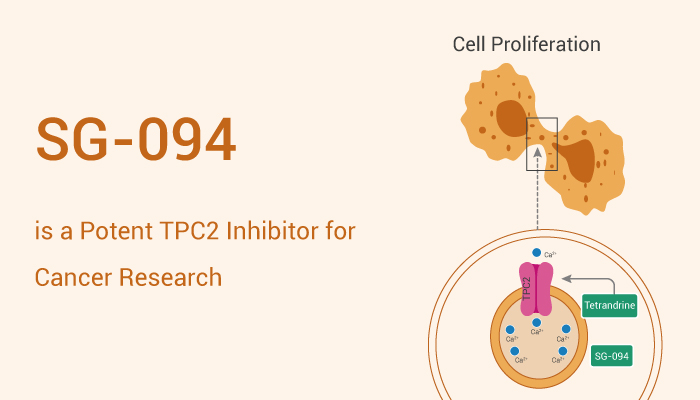TPC2 inhibitor, SG-094 can inhibit hepatocellular carcinoma (HCC) tumor growth by inhibiting two-pore channel 2 (TPC2). TPCs are eukaryotic intracellular voltage-gated and ligand-gated cation-selective ion channels. TPCs are an ancient family of ion channels. SG-094 exists in the membranes of acidic organelles such as endosomes and lysosomes. These organelles mediate biomolecule transport and the breakdown and serve as stores of calcium ions Ca2+. Studies with TPC knockout and knockdown models have revealed that these channels participate in the regulation of multiple endolysosomal trafficking pathways which when dysregulated can lead to or influence the development of a range of different diseases such as lysosomal storage, metabolic, or infectious diseases.
Mammalian cells express three TPCs: TPC1, TPC2, and TPC3. In humans, TPC1s are sodium selective and TPC2s conduct sodium ions, calcium ions, and possibly hydrogen ions. Meanwhile, plant TPC1s are non-selective channels. TPC2 is the major lysosomal targeted isoform, is a cation channel with selectivity for Ca2+ that will enable it to act as a Ca2+ release channel in the cellular environment. NAADP opens TPC2 channels in a concentration-dependent manner, binding to high-affinity activation and low-affinity inhibition sites. Therefore, some key roles of TPCs include calcium-dependent responses in muscle contraction(s), hormone secretion, fertilization, and differentiation.
SG-094 is a potent TPC2 inhibitor.

Specifically, SG-094 blocks PI(3,5)P2-elicited TPC2 currents on isolated endolysosomes from HEK293 cells expressing TPC2-EGFP. Besides, SG-094 significantly reduces VEGF-induced phosphorylation of eNOS, JNK, MAPK, and AKT without decreasing their total protein levels in HUVECs. Therefore, SG-094 shows antiproliferative effects against RIL175 cells. Meanwhile, SG-094 inhibits hepatocellular carcinoma (HCC) tumor growth in mice.
All in all, SG-094 is a potent TPC2 inhibitor that has potential for cancer research.
References:
[1]. Grimm C, et, al. Front Pharmacol. 2017 Feb 7;8:45.
[2]. Müller M, et, al. Cell Chem Biol. 2021 Aug 19;28(8):1119-1131.e27.